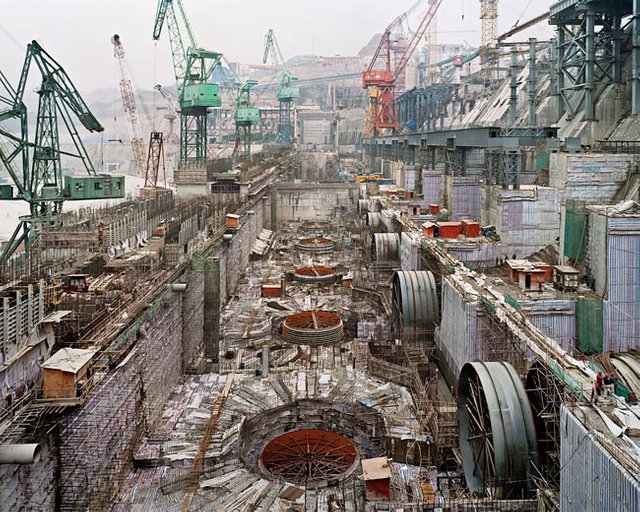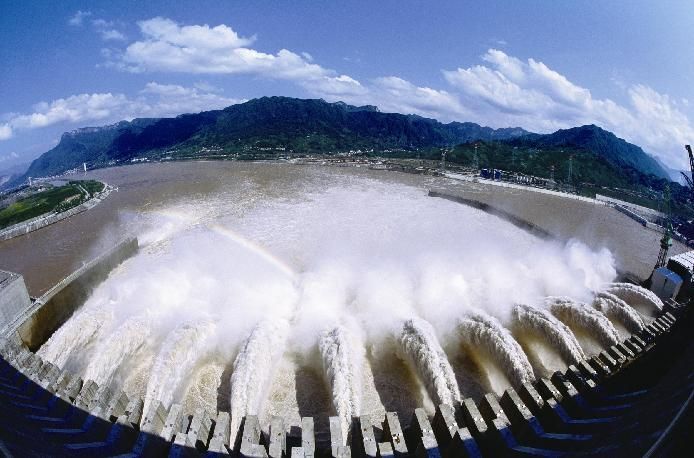The Three Gorges Dam, the largest in the world
The Yangtze River - known in China as Changjiang ("the long river") - has a length of 6,300 km. It is the longest river course in China, and the third in the world after the Amazon and the Nile. It constitutes, along with the Huang He or Yellow River, the cradle of the Chinese nation. It rises at an altitude of 5,800 m, on the Janggaingting Glacier of the Qinghai-Tibet Plateau, and from there it flows to the sea.
Most of the Yangtze basin has abundant rainfall, mainly in spring and summer, and an average rainfall of 1,100 mm per year. The water resources are, therefore, very abundant. The average annual contribution of the Yangtze is 1,000 km³: about ten times that of all Spanish rivers combined! This represents an average annual flow of 31,800 m³ / sec. In fact, it is the third largest river in the world after the Amazon and the Congo.
The conjunction of such important water flows with significant water falls makes the technically exploitable hydroelectric potential of the Yangtze River one of the largest in the world, with about 270 GW. But this source of great hydraulic and energy resources is also a major danger for the riverside populations, due to its devastating avenues, mainly in the middle and lower reaches of the river.
From 185 a.C., during the Han dynasty, until the end of imperial China in 1911 there are 214 historical references to catastrophic floods, representing an average frequency of a flood every ten years. One of the most punished and dangerous areas facing the floods is the beginning of its middle course, downstream from Yichang to Wuhan.

The Three Gorges Dam
On June 6, 2006, the last retaining wall of the dam was demolished, with enough explosives to demolish 400 buildings of 10 floors. It was completed on October 30, 2010. Almost 2 million people were resettled mainly in new neighborhoods built in the city of Chongqing.
The gorges of the Yangtze
The first considerations on the use of the Yangtze River in the section known as Three Gorges go back to the 1920s, when the first president of the Republic of China, Su Yat-sen, launched the idea of using the hydroelectric potential of the river to a new development of the country. Since then, a multitude of studies, projects and analyzes have taken place on the construction of a dam in the place. This has been one of the most controversial and debated topics in China from the technical, social, economic and political perspectives. The controversies lasted more than 70 years. Finally, on April 3, 1992, after numerous discussions, the 5th session of the VII National People's Congress gave the green light to the project.
The Three Gorges Dam is located on the upper course of the river, in the Xilling Gorge, about 40 km upstream from the city of Yichang (in the Sandouping area). It is one of the most spectacular and wonderful scenarios in China. The stretch of the Three Gorges is about 200 km long: it starts in the city of Fengjie and ends in the vicinity of Yichang. There the river cuts some impressive limestone and granite formations that have given rise to the three famous gorges that give it its name: the Qutang, the Wuxia and the Xiling.
The construction of the dam lasted 17 years. It was developed in three phases, between 1993 and 2009. It consists of the following main elements: a central spillway with 22 surface gates; two hydroelectric power stations -one on each side of the landfill- and two navigation structures: the locks (for ships up to 10,000 t) and a vertical lift (for ships up to 3,000 t).
characteristics
The dam rises on the banks of the city of Yichang, in the province of Hubei. The reservoir is named Gorotkia, and can store 39.3 billion cubic meters. It has 32 turbines of 700 MW each, 14 installed on the north side of the dam, 12 on the south side of the dam and six more underground totaling a power of 24,000 MW.
In the original plans, this single dam would have the capacity to provide 10% of the demand for electricity in China. However, the growth in demand has been exponential, and it would only be able to provide energy to 3% of Chinese domestic consumption.
This monumental work left under water level 19 cities and 322 towns, affecting almost 2 million people and submerging some 630 km2 of surface of Chinese territory.
Building
The beginning of the construction of the dam officially began on December 14, 1994, although the excavations and the transport of debris in the construction site had begun since 1993, culminating the construction in 2008 and it was not until the year 2012 , when it began to work to its full capacity this because the last of its 32 huge turbine generators was put into operation. During its construction 8,000 workers worked in the complex, but they were more than 30,000 in the days of most activity.

Lengths of the dam
The dam measures 2.3 kilometers in length and 185 meters in height (with 175 m of water in the normal level of storage or normal level of the reservoir); Its total storage capacity is estimated at 39, 300 million cubic meters and 22, 100 million cubic meters of flood control capacity, and it includes a lock capable of handling ships of up to 3,000 tons.
The largest hydroelectric power plant in the world
The production of electrical energy is the main objective of the dam. With its 22,500 MW capacity, it is the largest hydroelectric plant in the world. The average annual production was initially evaluated at 88.2 TWh / year. In 2014 it reached 98.8 TWh per year, a world record. Being a renewable source of energy, the dam has led to the reduction of some 100 million tons of carbon dioxide, a figure that has helped improve the situation of emissions in China. Energy generation has also contributed to social and economic development, since it has been transported to the eastern coastal areas.
Brake to the floods
Another of the primary objectives of the Three Gorges Dam is the rolling of avenues. The operation scheme of the reservoir is based on lowering the water level from the end of the month of May to the beginning of June to the level 145 m, maintaining throughout the monsoon season (until the end of September). This allows an additional volume of 22,150 hm³ (56.3% of the capacity of the reservoir) to be available during the flood season. The protection of the section below the dam to the city of Wuhan will pass from a return period of 10 years to one of 100 years. And with the flood management of Dongting Lake, protection against floods of around 1,000 years of return period could be achieved.
In 2010, the worst flood of the last decade put the dam to the test in its function of flooding avenues. In the month of July, the peak of the entrance to the reservoir was 70,000 m³ / sec, and the dam drained a maximum flow of 40,000 m³ / sec, which meant a reduction of the peak of avenue of 43%. Again, in July 2012, the dam experienced the highest flood since the beginning of its operation, with an input of 71,200 m³ / sec and a maximum output of 43,000 m³ / sec, and a peak reduction of 40%. A first general assessment of the damage avoided shows that its amount was an important percentage of the total cost of the project.
Another benefit provided by the dam is the improvement of safety in navigation in the important Chongqing-Shanghái waterway. The reduction of accidents by 60% has boosted river transport, which has reached more than 100 million tons per year. The minimum river flows downstream of the dam have also increased, which have gone from around 3,000 m³ / sec to 5,000 m³ / sec.

The impact of the megaproject
The flood produced by the reservoir had a great social impact on the population settled on the banks of the Three Gorges. It caused the displacement of 1,240,000 people, the destruction of 34.6 million m² of houses and the affection to 24,500 hectares of cultivation, 1,600 factories and 825 km of roads. This was a region of low development, with a high percentage of poverty. 60% of the population was urban and 40% resided in small rural settlements. A long process of relocation and resettlement has taken place, in which, in general, the old cities have been demolished and rebuilt in the same area but at higher elevations, far from the flooded area, with which they have improved the living standards of those people.
The biggest problems and protests occurred in the rural population: some 150,000 people had to be resettled in other regions, while the rest were relocated in industrial activities (60%). It should also be noted that the young population saw the transfer as an opportunity for change, while the older population was much more reluctant.
Another significant impact was the increase in the contamination of the dammed waters. In the 1990s the direct discharge to the river -with little or no treatment- of the effluents was very high, about 1,000 million tons per year, and as a consequence, in the dammed water there was a reduction in speed and they decreased significantly the processes of self-purification. To avoid this, a long process, still unfinished, began to control spills, shut down the most polluting factories and build many treatment plants.
Sediments were also considered a key element. In natural conditions, the river transported about 526 million tons of sediment per year, 90% of them accumulated in the avenues. When building the dam, there was a retention of part of the sediments. Efficient discharge techniques have been developed coinciding with flood drainage.
The effect of the dam and the backwater in the reservoir could alter the aquatic ecology and affect some species, which were already threatened by the poor ecological status and quality of the waters, such as the Chinese dolphin, the Chinese sturgeon and the Yangtze sturgeon. For this, apart from the essential improvement of the water quality, an extensive program of monitoring of the threatened species and a research and artificial breeding station in the city of Yichang was established.
Why the name of the three gorges?
Its name is due to three important gorges passing through it (valley or narrow passage that is wedged between mountains): the Xiling Gorge, which is the longest with great rapids and impressive rock formations, then the Wu Gorge, and finally the Gorge Qutang which is the shortest, but nevertheless the prettiest.
Amount of energy generated
Initially, two power plants with 26 hydro turbines were projected (14 in the left bank and 12 on the right), thus having a generation capacity of 18,200 MW (700 MW per turbine), which each year would provide, in average, 84700 million kW per hour - in this way it would become the largest hydroelectric plant in the world. However, a subsequent revision led to the inclusion in the project of the construction of a new underground plant on the right bank with six turbines of 700 MW, which increased the generation capacity of the dam to 22 400 MW (85 TWh annually).
References for more information
http://www.chinatraveldepot.com/C150-China-Geography
You received a 10.0% upvote since you are not yet a member of geopolis.
To read more about us and what we do, click here.
https://steemit.com/geopolis/@geopolis/geopolis-the-community-for-global-sciences-update-3
If you do not want us to upvote and comment on your posts concerning earth and earth sciences, please reply stop to this comment and we will no longer bother you with our love ❤️